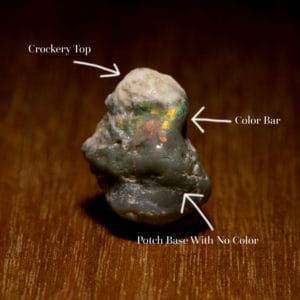I’ve been cutting some new nobby rough opal from Lightning Ridge. I thought it be good to share some of the unique features of these type of formations.
I’ve selected an example to work on in the image below.
The one thing that many (but not all) of these nobbies have in common is a potch base and a white cap on top. We see this a lot in rich deposits of opal. Some of the main opal fields including places like Jag Hill, Wyoming, and much of the Coocoran opal fields all have this in common.
The Nobby

You can see from the bottom up of this piece there is good potch as a base for the color bar to sit on. When you take off the white top there is a nice thick bar of color to make a high domed gem opal.
Unique Features
-
Crockery Top
The white material on the top of this opal nobby is what some would call a crockery top, white matrix or even just white potch. It is a great indicator that color could be formed in the piece. The white top is usually formed quite thin and when color is formed under it, it is usually clean and bright.
-
Color Bar
Just underneath this crockery top is where the color can sit a lot of the time. And the best color is usually closest to the white. So it is paramount to be very careful when cutting these gems so as not to lose the good color sitting just underneath. Sometimes the color bar can be super thin but blindingly bright. Many people can totally miss it and not know it’s there. Some even will grind them away without knowing. This is why I say to take is slow and cut bit by bit as baby steps is the best way (like most things in life!).
-
Potch
The third and probably the most important feature of nobby rough opal is the potch on the bottom. Without this we would not have black opals. This black potch is what makes Lightning Ridge opal so prized. Sometimes a light grey skin can be formed on the outside of these rough pieces. By grinding in just enough to take the skin off the opal, it can turn black. When this happens the value of the opal can sky rocket in value. No other country in the world produces black nobby opal in sedimentary form like in Lightning Ridge.
We in the opal cutting game love the white crokery top because a lot of the time it means one thing. There is color below!
Later this week we will take a look and cut the opal to see if our dreams will come true.





I love watching you rub opal. I want to try my hand on a few knobbies.
Yes it is fun you must try it sometime
I killed a 14ct n1 royal blue nobby i went for bettercolour that wasnt there ,on plus side i got a complete tiny crystal dinosaur bone
It happens my friend